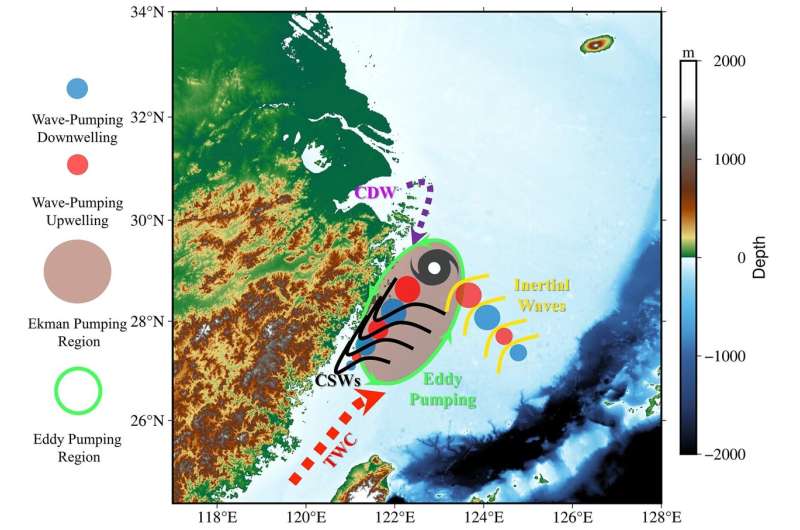How do typhoons trigger coastal algal blooms?

A research team led by Prof. Yin Baoshu from the Institute of Oceanology of the Chinese Academy of Sciences (IOCAS) has revealed how typhoons trigger coastal algal blooms.
The study was published in Journal of Geophysical Research: Oceans on May 9.
Harmful algal blooms are increasingly reported off the coasts of Zhejiang Province, China. In the region, there is a complicated circulation pattern related to the Changjiang River Diluted Water (CDW), the Taiwan Warm Current (TWC), the Kuroshio Current (KC), as well as exchanges between the East China Sea (ECS) and the KC.
In addition, typhoons (hurricanes or tropical cyclones) developing in the Western North Pacific frequently reach this area in the warm season, and algal bloom in the near-shore regions increase after typhoons.
Though the phosphate input from the intrusion of the Kuroshio Subsurface Water (KSSW) contributes to the growth of the plankton, the mechanism of typhoon-induced algal blooms remains unclear.
In this study, the researchers identified three types of typhoon-induced upwellings that are responsible for KSSW outcropping and are highly related to the algal blooms.
They used a fine-resolution coupled physical-biological model based on Regional Ocean Model System (ROMS) to reproduce oceanic responses during super-typhoon Chan-hom. The modeled surface chlorophyll-a results were highly consistent with satellite data, indicating a significant algal bloom phenomenon along the coast of Zhejiang Province.
Through three-dimensional dynamic diagnostics, the researchers revealed three types of typhoon-induced upwellings: the classical linear wind-Ekman pumping, nonlinear wave pumping (low-frequency coastal shelf waves along the coasts and high-frequency near-inertial waves along the typhoon track), and eddy-induced pumping.
"These upwellings make the phosphate-rich bottom KSSW outcrop and then available to the subsequent phytoplankton blooms," said Li Yuxuan, first author of the study.
Typhoon Chan-hom provided a good subject for the study of multiple upwelling mechanisms. These upwellings, along with vertical mixing, provided abundant nutrients from the bottom to the upper ocean, facilitating the occurrence of algal blooms after typhoons.
"The nonlinear processes should be considered in ecological response to typhoons and this work proved the close connection between physical processes and marine environment changes again," said Dr. Yang Dezhou, corresponding author of the study.
Furthermore, this study proposed a diagnostic method for upwelling and revealed the general dynamic mechanisms of typhoon-induced upwellings on the continental shelf.
More information: Yuxuan Li et al, Three Types of Typhoon‐Induced Upwellings Enhance Coastal Algal Blooms: A Case Study, Journal of Geophysical Research: Oceans (2022). DOI: 10.1029/2022JC018448
Provided by Chinese Academy of Sciences



















